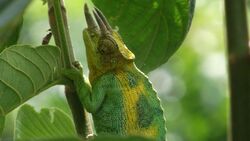Biology:Trioceros johnstoni
| Trioceros johnstoni | |
|---|---|

| |
| Male | |
| Scientific classification | |
| Domain: | Eukaryota |
| Kingdom: | Animalia |
| Phylum: | Chordata |
| Class: | Reptilia |
| Order: | Squamata |
| Suborder: | Iguania |
| Family: | Chamaeleonidae |
| Genus: | Trioceros |
| Species: | T. johnstoni
|
| Binomial name | |
| Trioceros johnstoni (Boulenger, 1901)
| |
| Synonyms[2] | |
| |
Trioceros johnstoni, known commonly as Johnston's chameleon, Johnston's three-horned chameleon, or the Ruwenzori three-horned chameleon, is a species of chameleon, a lizard in the family Chamaeleonidae.[3] It is endemic to highlands in the Albertine Rift in central Africa.[1] It reaches up to 30 cm (12 in) in total length and only the adult male has three horns; females are hornless.[4]
Taxonomy and etymology
The three long annulated horns in the male T. johnstoni makes it superficially similar to T. jacksonii and T. werneri, and to extent also to the short-horned T. fuelleborni and the smooth-horned T. oweni,[4] but they are not close relatives.[5] Its nearest relative is the hornless T. ituriensis.[5]
The specific name johnstoni was given in honor of the British explorer Harry Johnston.[6][7]
Distribution and habitat
T. johnstoni is found in forests at altitudes between 1,000 and 2,500 m (3,300–8,200 ft) in the Albertine Rift of eastern Democratic Republic of the Congo, western Burundi, western Rwanda, and southwestern Uganda, but also tolerates semi-urbanized environments as long as some trees and bushes remain.[1]
Behaviour
Males of T. johnstoni are fiercely territorial and readily will fight other males, using their horns and biting.[4] T. johnstoni is oviparous, with the female laying 4–23 eggs per clutch.[5]
References
- ↑ 1.0 1.1 1.2 Tolley, K.; Plumptre, A. (2014). "Trioceros johnstoni". IUCN Red List of Threatened Species 2014: e.T172573A1345950. doi:10.2305/IUCN.UK.2014-3.RLTS.T172573A1345950.en. https://www.iucnredlist.org/species/172573/1345950. Retrieved 20 November 2021.
- ↑ "Trioceros johnstoni ". The Reptile Database. www.reptile-database.org.
- ↑ Tilbury, C.R. (2010). Chameleons of Africa: An Atlas, Including the Chameleons of Europe, the Middle East and Asia. Frankfurt: Edition Chimaira.
- ↑ 4.0 4.1 4.2 Spawls, S.; Howell, K.; Drewes, R.; Ashe, J. (2002). A Field Guide to the Reptiles of East Africa. Academic Press. pp. 228–229. ISBN 0-12-656470-1.
- ↑ 5.0 5.1 5.2 Hughes, D.F.; Blackburn, D.G. (2020). "Evolutionary origins of viviparity in Chamaeleonidae". Journal of Zoological Systematics and Evolutionary Research 58 (1): 284–302. doi:10.1111/jzs.12328.
- ↑ Boulenger, G. A. (1901). "Description of two new Chameleons from Mount Ruwenzori, British East Africa". Proceedings of the Zoological Society of London 2: 135–136, Plates XII-XIII. doi:10.1111/j.1469-7998.1901.tb08168.x.
- ↑ Beolens, Bo; Watkins, Michael; Grayson, Michael (2011). The Eponym Dictionary of Reptiles. Baltimore: Johns Hopkins University Press. xiii + 296 pp. ISBN:978-1-4214-0135-5. (Trioceros johnstoni, p. 135).
Wikidata ☰ Q3014927 entry
 |


